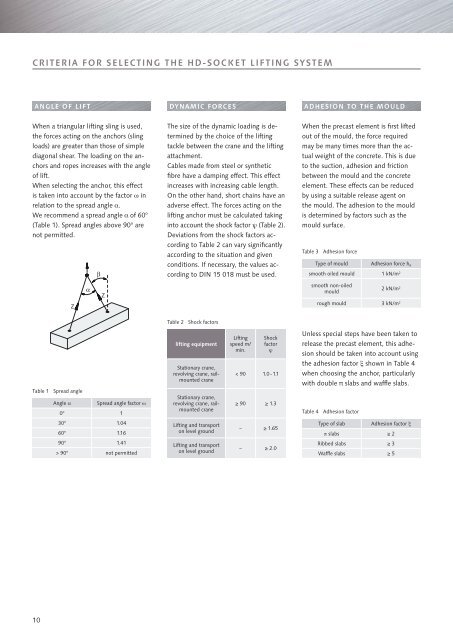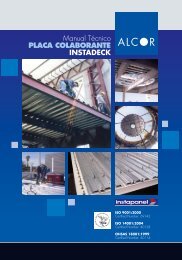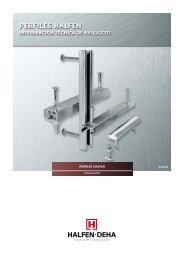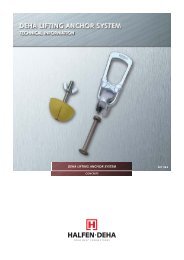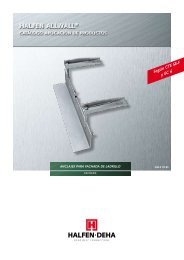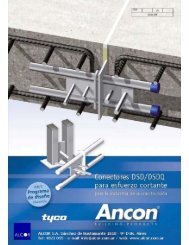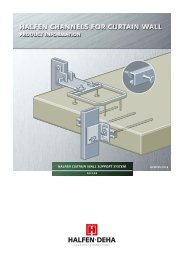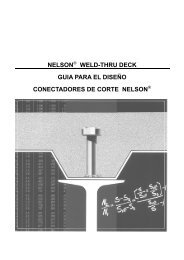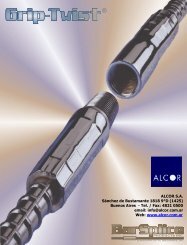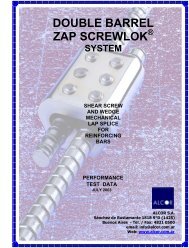DEHA HD-SOCKET LIFTING SYSTEM - Alcor SA
DEHA HD-SOCKET LIFTING SYSTEM - Alcor SA
DEHA HD-SOCKET LIFTING SYSTEM - Alcor SA
- No tags were found...
You also want an ePaper? Increase the reach of your titles
YUMPU automatically turns print PDFs into web optimized ePapers that Google loves.
CRITERIA FOR SELECTING THE <strong>HD</strong>-<strong>SOCKET</strong> <strong>LIFTING</strong> <strong>SYSTEM</strong>ANGLE OF LIFTDYNAMIC FORCE<strong>SA</strong>DHESION TO THE MOULDWhen a triangular lifting sling is used,the forces acting on the anchors (slingloads) are greater than those of simplediagonal shear. The loading on the anchorsand ropes increases with the angleof lift.When selecting the anchor, this effectis taken into account by the factor inrelation to the spread angle.We recommend a spread angleof 60°(Table 1). Spread angles above 90° arenot permitted.The size of the dynamic loading is determinedby the choice of the liftingtackle between the crane and the liftingattachment.Cables made from steel or syntheticfibre have a damping effect. This effectincreases with increasing cable length.On the other hand, short chains have anadverse effect. The forces acting on thelifting anchor must be calculated takinginto account the shock factor (Table 2).Deviations from the shock factors accordingto Table 2 can vary significantlyaccording to the situation and givenconditions. If necessary, the values accordingto DIN 15 018 must be used.When the precast element is first liftedout of the mould, the force requiredmay be many times more than the actualweight of the concrete. This is dueto the suction, adhesion and frictionbetween the mould and the concreteelement. These effects can be reducedby using a suitable release agent onthe mould. The adhesion to the mouldis determined by factors such as themould surface.Table 3 Adhesion forceType of mouldAdhesion force h asmooth oiled mould 1 kN/m 2smooth non-oiledmould2 kN/m 2rough mould 3 kN/m 2Table 2 Shock factorsTable 1 Spread angleAngle Spread angle factor 0° 1lifting equipmentStationary crane,revolving crane, railmountedcraneStationary crane,revolving crane, railmountedcraneLiftingspeed m/min.Shockfactor< 90 1.0 - 1.1≥ 90 ≥ 1.3Unless special steps have been taken torelease the precast element, this adhesionshould be taken into account usingthe adhesion factor shown in Table 4when choosing the anchor, particularlywith double π slabs and waffle slabs.Table 4 Adhesion factor30° 1.0460° 1.16Lifting and transporton level ground– ≥ 1.65Type of slabAdhesion factor slabs ≥ 290° 1.41> 90° not permittedLifting and transporton level ground– ≥ 2.0Ribbed slabs ≥ 3Waffle slabs ≥ 510


